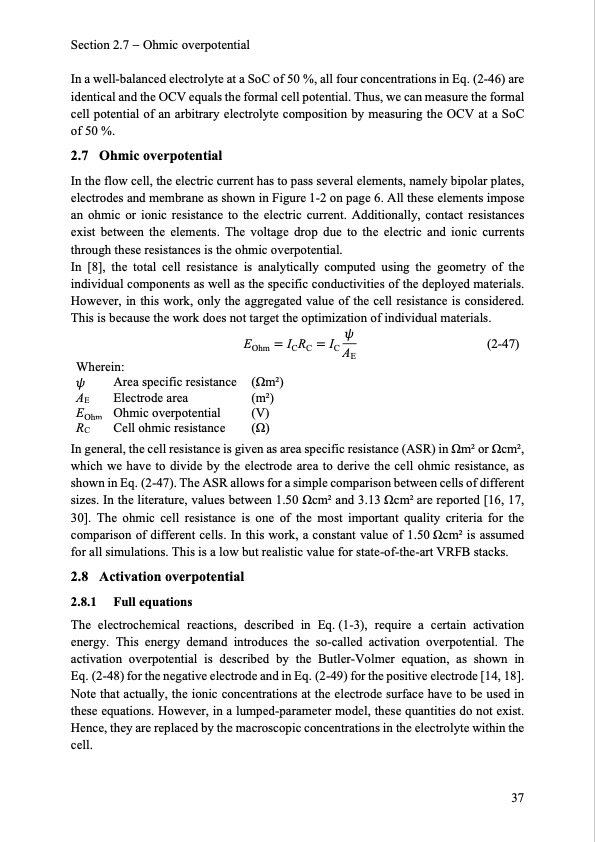
PDF Publication Title:
Text from PDF Page: 045
Section 2.7 Ohmic overpotential In a well-balanced electrolyte at a SoC of 50 %, all four concentrations in Eq. (2-46) are identical and the OCV equals the formal cell potential. Thus, we can measure the formal cell potential of an arbitrary electrolyte composition by measuring the OCV at a SoC of 50 %. 2.7 Ohmic overpotential In the flow cell, the electric current has to pass several elements, namely bipolar plates, electrodes and membrane as shown in Figure 1-2 on page 6. All these elements impose an ohmic or ionic resistance to the electric current. Additionally, contact resistances exist between the elements. The voltage drop due to the electric and ionic currents through these resistances is the ohmic overpotential. In [8], the total cell resistance is analytically computed using the geometry of the individual components as well as the specific conductivities of the deployed materials. However, in this work, only the aggregated value of the cell resistance is considered. This is because the work does not target the optimization of individual materials. Wherein: Area specific resistance (Ωm2) AE Electrode area (m2) EOhm Ohmic overpotential (V) RC Cell ohmic resistance (Ω) E Ohm IR I C C CAE (2-47) In general, the cell resistance is given as area specific resistance (ASR) in Ωm2 or Ωcm2, which we have to divide by the electrode area to derive the cell ohmic resistance, as shown in Eq. (2-47). The ASR allows for a simple comparison between cells of different sizes. In the literature, values between 1.50 Ωcm2 and 3.13 Ωcm2 are reported [16, 17, 30]. The ohmic cell resistance is one of the most important quality criteria for the comparison of different cells. In this work, a constant value of 1.50 Ωcm2 is assumed for all simulations. This is a low but realistic value for state-of-the-art VRFB stacks. 2.8 Activation overpotential 2.8.1 Full equations The electrochemical reactions, described in Eq. (1-3), require a certain activation energy. This energy demand introduces the so-called activation overpotential. The activation overpotential is described by the Butler-Volmer equation, as shown in Eq. (2-48) for the negative electrode and in Eq. (2-49) for the positive electrode [14, 18]. Note that actually, the ionic concentrations at the electrode surface have to be used in these equations. However, in a lumped-parameter model, these quantities do not exist. Hence, they are replaced by the macroscopic concentrations in the electrolyte within the cell. 37PDF Image | Model-based Design Vanadium Redox Flow Batteries

PDF Search Title:
Model-based Design Vanadium Redox Flow BatteriesOriginal File Name Searched:
10-5445IR1000070670.pdfDIY PDF Search: Google It | Yahoo | Bing
Salgenx Redox Flow Battery Technology: Salt water flow battery technology with low cost and great energy density that can be used for power storage and thermal storage. Let us de-risk your production using our license. Our aqueous flow battery is less cost than Tesla Megapack and available faster. Redox flow battery. No membrane needed like with Vanadium, or Bromine. Salgenx flow battery
| CONTACT TEL: 608-238-6001 Email: greg@salgenx.com | RSS | AMP |